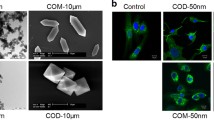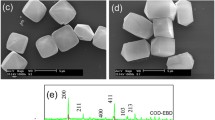Abstract
Since hypercalciuria is a common feature of idiopathic calcium oxalate (CaOx) nephrolithiasis, renal epithelial cells of stone patients are exposed to various crystals in the presence of high calcium. This study was performed to determine the effect of high calcium levels on CaOx crystal-induced cell injury. We exposed human renal epithelial cell line, HK2 in vitro to CaOx monohydrate crystals at a concentration of 133 μg/cm2 for 1, 3, 6 or 12 h in the presence or absence of 5 or 10 mM/L calcium Ca++. We determined the release of lactate dehydrogenase as marker of injury and hydrogen peroxide (H2O2) and 8-isoprostane (8-IP) as sign of oxidative stress. Cells were also examined after trypan blue and nuclear DNA staining with 4′,6-diamidino-2-phenylindole to determine their membrane integrity and apoptosis respectively. Exposure of cells to 5 or 10 mM/L of Ca++, for up-to 6 h, resulted in increased trypan blue and DAPI staining and production of H2O2. Similarly an exposure to CaOx crystals also resulted in increased trypan blue and DAPI staining and H2O2 production. An exposure to 5 mM/L Ca or CaOx crystals also resulted in increased production of 8-IP. A combination of the two treatments, Ca and CaOx crystals, did not show anymore changes than exposure to high Ca or CaOx crystals alone, except in the case of a longer exposure of 12 h. Longer exposures of 12 h resulted in cells sloughing from the substrate. These results indicate that exposure to high levels of Ca or CaOx crystals is injurious to renal epithelial cells but the two do not appear to work synergistically. On the other hand, results of our earlier studies suggest that oxalate and CaOx crystals work in synergy, i.e., CaOx crystals are more injurious in the presence of high oxalate. Perhaps Ox and CaOx crystals activate different biochemical pathways while Ca and CaOx crystals affect the identical pathways.



Similar content being viewed by others

References
Worcester E, Coe FL (2008) Nephrolithiasis. Prim Care Clin Off Pract 35:369–391. doi:10.1016/j.pop.2008.01.005
Khan SR (2005) Hyperoxaluria-induced oxidative stress and antioxidants for renal protection. Urol Res 33:349–357. doi:10.1007/s00240-005-0492-4
Thamilselvan S, Khan SR, Menon M (2003) Oxalate and calcium oxalate mediated free radical toxicity in renal epithelial cells: effect of antioxidants. Urol Res 31:3–9
Jonassen JA, Cao LC, Honeyman T, Scheid CR (2003) Mechanisms mediating oxalate-induced alterations in renal cell functions. Crt Rev Eukar Gene Expr 13:55–72. doi:10.1615/CritRevEukaryotGeneExpr.v13.i1.50
Khand FD, Gordge MP, Robertson WG, Noronha-Dutra AA, Hothersall JS (2002) Mitochondrial superoxide production during oxalate mediated oxidative stress in renal epithelial cells. Free Radic Biol Med 32:1339–1350. doi:10.1016/S0891-5849(02)00846-8
Thamilselvan S, Byer KJ, Hackett RL, Khan SR (2000) Free radical scavengers, catalase and superoxide dismutase provide protection from oxalate-associated injury to LLC-PK1 and MDCK cells. J Urol 164:224–229. doi:10.1016/S0022-5347(05)67499-X
Hackett RL, Shevock PN (1994) Madin-Darby Canine Kidney Cells are injured by exposure to oxalate and calcium oxalate crystals. Urol Res 22:197–204. doi:10.1007/BF00541892
Baggio B, Gambaro G, Ossi E, Favaro S, Boesatti A (1983) Increased urinary excretion of renal enzymes in idiopathic calcium oxalate nephrolithiasis. J Urol 129:1161
Tungsanga K, Sriboonlue P, Futrakul P, Yachantha C, Tosukhowong P (2005) Renal tubular cell damage and oxidative stress in renal stone patients and the effect of potassium citrate treatment. Urol Res 33:65–69. doi:10.1007/s00240-004-0444-4
Thamilselvan S, Hackett RL, Khan SR (1997) Lipid peroxidation in ethylene glycol induced hyperoxaluria and calcium oxalate nephrolithiasis. J Urol 157:1059–1063. doi:10.1016/S0022-5347(01)65141-3
Lieske JC, Farell, Deganello S (2004) The effect of ions at the surface of calcium oxalate monohydrate crystals on cell-crystal interactions. Urol Res 32:117–123. doi:10.1007/s00240-003-0391-5
Verkoelen CF (2006) Crystal retention in renal stone disease: a crucial role for the glycosaminoglycan hyaluronan? J Am Soc Nephrol 17:1673–1687. doi:10.1681/ASN.2006010088
Khan SR (1995) CaOx crystal interaction with renal epithelium, mechanism of crystal adhesion and its impact on stone development. Urol Res 23:71–79. doi:10.1007/BF00307936
Khan SR, Byer KJ, Thamilselvan S, Hackett RL, McCormack WT, Benson NA, Vaughn KL, Erdos GW (1999) Crystal–cell interaction and apoptosis in oxalate-associated injury of renal epithelial cells. J Am Soc Nephrol 10:S457–S463
Lieska JC, Toback FG (2000) Renal cell–urinary crystal interactions. Curr Opin Nephrol Hypertens 9:349–355. doi:10.1097/00041552-200007000-00005
Rabinovich YI, Daosukho S, Byer K, El-Shall H, Khan SR (2008) Direct measurements of adhesion forces between calcium oxalate monohydrate and kidney epithelial cells in the presence of Ca2+ and Mg2+ ions. J Colloid Interface Sci 325:594–601. doi:10.1016/j.jcis.2008.06.024
Hidalgo C, Donoso P (2008) Crosstalk between calcium and redox signaling: from molecular mechanisms to health implications. Antioxid Redox Signal 10:1275–1312. doi:10.1089/ars.2007.1886
Acknowledgments
Research supported by NIH grants # RO1DK065658, Center for the Study of Lithiasis and Pathological Calcification. Dr. Khaskheli is recipient of a postdoctoral fellowship of Higher Education Commission of Government of Pakistan.
Author information
Authors and Affiliations
Corresponding author
Rights and permissions
About this article
Cite this article
Khaskhali, M.H., Byer, K.J. & Khan, S.R. The effect of calcium on calcium oxalate monohydrate crystal-induced renal epithelial injury. Urol Res 37, 1–6 (2009). https://doi.org/10.1007/s00240-008-0160-6
Received:
Accepted:
Published:
Issue Date:
DOI: https://doi.org/10.1007/s00240-008-0160-6



